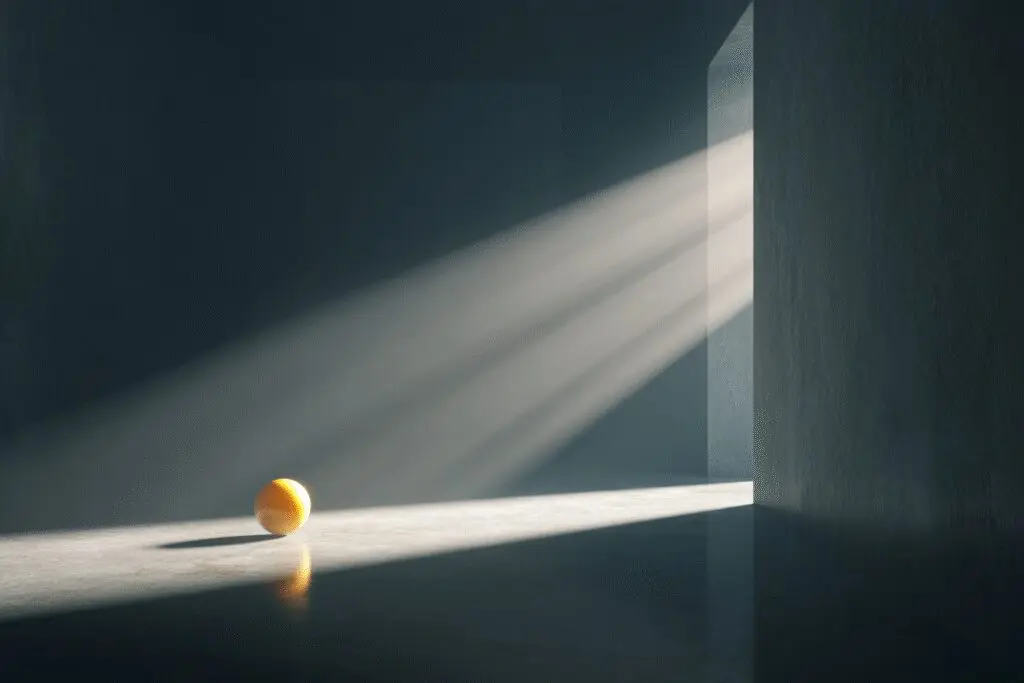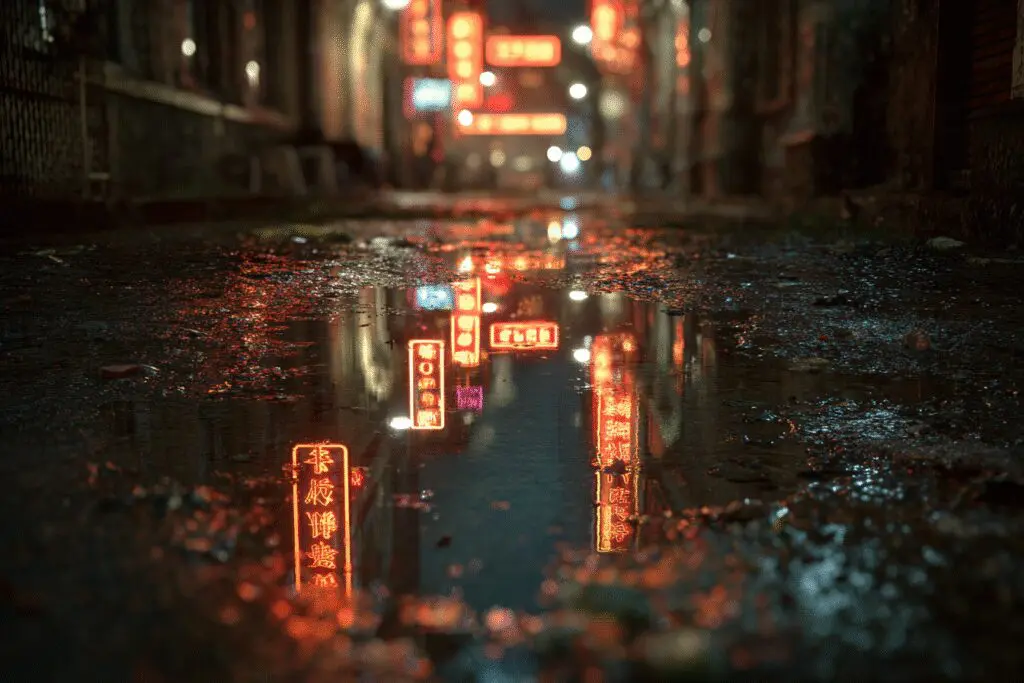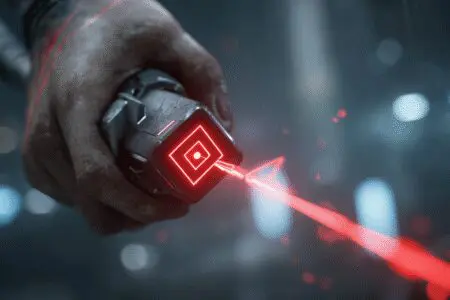Have you ever stopped playing a game, mid-action, not because you were tired, but because you were just mesmerized by a puddle on the ground? It sounds a little silly, but I’ve done it. You see the reflection of a flickering neon sign, the distorted image of a character walking by, and the soft glow from a streetlamp all blending together perfectly. It looks… real.
That incredible, almost spooky realism is the magic of ray tracing. For years, it was the holy grail of computer graphics, something you’d only see in Hollywood movies. Now, it’s in our games, and it’s changing everything. So, if you’ve been wondering what is ray tracing in gaming, you’ve come to the right place. We’re going to break it all down.
I remember my first real experience with it. I had just upgraded my rig and fired up Control. I walked into an office with polished marble floors, and I just stood there, moving my character back and forth. The reflections weren’t the usual blurry, faked approximations I was used to. I could see the ceiling lights, the chairs, the bizarre floating objects—everything, all rendered perfectly in the floor. It was the first time a game’s lighting felt truly authentic and not just a clever illusion.
More in Graphics Optimization Category
What Is Anti Aliasing in Games
So, What Is Ray Tracing in Gaming, Exactly?
At its core, ray tracing is a computer graphics technique that simulates the way light behaves in the real world. That’s it. Instead of using programming shortcuts and cheats to approximate what light should look like, it calculates the path of individual rays of light from their source (like a lightbulb or the sun) as they bounce around a virtual environment.
Think about how you see things right now. Light from your screen is traveling to your eyes. Light from the lamp in your room is bouncing off the walls, the desk, the cat, and then hitting your eyes. Ray tracing does the same thing, but in reverse. It traces paths from the virtual “camera” (your viewpoint in the game) outwards, calculating what each ray of light would hit. As it hits objects, it bounces, gets absorbed, or gets reflected, just like real light. By simulating this, games can create incredibly realistic shadows, reflections, and lighting that were impossible before.
Is It Really Just About Pretty Reflections?
Reflections are definitely the most obvious and flashy effect of ray tracing, but it goes so much deeper than that. It affects almost every aspect of how a scene is lit.
- Shadows: Ray-traced shadows are soft and natural. They have realistic edges that get blurrier the farther they are from the object casting them, just like in real life.
- Global Illumination: This is a big one. It’s how light bounces off surfaces and illuminates other objects. Imagine a red carpet in a white room. With ray tracing, the white walls near the carpet will pick up a subtle red glow. This makes scenes feel grounded and cohesive.
- Ambient Occlusion: This fancy term refers to the soft shadows that appear in the corners and crevices of objects where light has a hard time reaching. Ray tracing makes this effect far more accurate, adding a sense of depth and realism.
The ‘Old Way’: How Did Games Make Light Work Before Ray Tracing?
Before ray tracing became feasible for real-time gaming, developers used a technique called rasterization. For decades, rasterization has been the backbone of 3D graphics, and honestly, it’s an incredibly clever bag of tricks.
In simple terms, rasterization takes 3D models (made of triangles) and projects them onto your 2D screen. To create lighting effects, developers used all sorts of shortcuts. Shadows were often pre-calculated and “baked” into the environment or created using a technique called shadow mapping, which often resulted in hard, blocky edges. Reflections were usually done with “screen space reflections,” which could only reflect what was already visible on your screen. If an object moved off-screen, its reflection would pop out of existence.
Rasterization is fast and efficient, and artists have gotten incredibly good at faking realism with it. However, it’s still faking it. Ray tracing isn’t a trick; it’s a simulation.
How Does Ray Tracing Actually Work on My PC?
Alright, let’s get a little more technical, but I promise to keep it simple. The sheer amount of calculation needed for ray tracing is mind-boggling, which is why it was reserved for pre-rendered movie effects for so long. A single frame in a Pixar movie could take hours or even days to render on a massive server farm. Doing this 60 times per second on your home PC seemed like science fiction.
Imagine You’re a Ray of Light (No, Really)
The process, often called “backwards ray tracing,” is more efficient for gaming. Instead of simulating every single light ray from a source (most of which would never even reach the player’s view), the engine traces rays from the camera, backwards into the scene.
- A ray is shot out from the camera for each pixel on your screen.
- The engine figures out the first object that ray hits.
- From that intersection point, new rays are generated. One might bounce towards a light source to see if the point is in shadow. Another might bounce off in a reflected direction to see what it hits, creating a reflection. Another might bounce in a random direction to calculate ambient light.
- This process can repeat for several bounces to gather more light information.
Now, multiply this by the millions of pixels on your screen, and do it 60 or more times every second. The computational power required is immense, and that’s why we needed specialized hardware to make it happen in real-time.
What’s the Difference Between Ray Tracing and Path Tracing?
You might hear the term “path tracing” thrown around, especially with amazing-looking mods like Cyberpunk 2077’s RT Overdrive mode. Path tracing is essentially a more intense, more pure form of ray tracing.
While basic ray tracing might only calculate one or two light bounces, path tracing calculates many, many bounces for each ray. This allows it to simulate global illumination and other complex light interactions far more accurately. The result is astonishingly realistic, but the performance cost is massive. Right now, path tracing is at the absolute cutting edge and requires the most powerful hardware available.
Why Do I Keep Hearing “RTX” and Not Just “Ray Tracing”?
This is a great question and often a point of confusion. Ray tracing is the technique. RTX is NVIDIA’s brand name for its hardware and software platform that makes real-time ray tracing possible.
When NVIDIA launched their GeForce 20 series cards, the big innovation was the inclusion of dedicated hardware cores for this task:
- RT Cores: These are specialized processors on the GPU designed for one thing: calculating ray intersections at lightning speed. They handle the heavy lifting of ray tracing, freeing up the main GPU shaders to do everything else.
- Tensor Cores: These cores are designed for AI and deep learning, and they are crucial for technologies like DLSS (Deep Learning Super Sampling), which we’ll get to in a bit.
Is RTX Just a Marketing Term from NVIDIA?
Yes and no. It’s definitely a brand name, but it also represents a complete platform. When a game says it has “RTX On,” it means it’s using the NVIDIA RTX platform, which includes ray tracing effects and often DLSS, to run them efficiently. It was a huge marketing push, and for good reason—it represented a fundamental shift in graphics technology.
Do AMD and Consoles Have Ray Tracing Too?
Absolutely. While NVIDIA was first to market with dedicated hardware, AMD has since included its own hardware acceleration for ray tracing in their RDNA 2 and newer graphics cards (the Radeon RX 6000 series and beyond). The PlayStation 5 and Xbox Series X/S also have this capability.
The underlying technology being used is often an open standard like Microsoft’s DirectX Raytracing (DXR) or Vulkan Ray Tracing. This means developers can implement ray tracing in their games, and it will work on any hardware that supports the standard, whether it’s from NVIDIA or AMD. The performance and feature sets can vary, but the core technology is becoming widespread.
What Are the Main Types of Ray Tracing Effects I’ll See in Games?
When you go into a game’s graphics menu, you won’t just see a single “Ray Tracing: On/Off” toggle. Usually, you can enable specific effects. I spent a good hour in Alan Wake 2 just flipping these on and off to see the difference.
Here are the big ones you’ll typically encounter:
- Ray-Traced Reflections: This is the most noticeable effect. It replaces those fake screen-space reflections with physically accurate ones. Puddles, windows, mirrors, and shiny floors will reflect the entire world around them, even objects that are off-screen.
- Ray-Traced Shadows: This creates soft, realistic shadows that diffuse and sharpen depending on the light source’s distance and size. It eliminates the blocky or unrealistic shadow edges you see with traditional methods.
- Ray-Traced Global Illumination (RTGI): This is the subtle superstar. It simulates how light bounces off surfaces, coloring the world around it. It adds a profound sense of realism and cohesiveness to a scene that’s hard to un-see once you get used to it.
- Ray-Traced Ambient Occlusion (RTAO): This creates more accurate contact shadows where objects meet or where light is blocked. It adds depth and makes objects feel more grounded in the environment.
Will Turning On Ray Tracing Tank My Performance?
Let’s be honest with each other. Yes, turning on ray tracing is incredibly demanding. It’s doing calculations that were considered impossible for real-time applications just a decade ago. Firing it up, especially at higher resolutions and with multiple effects enabled, will result in a significant drop in your frames per second (FPS).
Let’s Talk About the FPS Hit: Is It Worth It?
This is the million-dollar question, and the answer is personal. For a fast-paced competitive shooter like Call of Duty, I’d probably turn it off to maximize my frame rate and responsiveness. A high FPS is more important than pretty shadows when someone is about to get the drop on you.
However, for a slower-paced, atmospheric single-player game like Cyberpunk 2077 or Metro Exodus, the visual upgrade can be completely transformative. The enhanced immersion from the realistic lighting can fundamentally change the experience. I tried playing Cyberpunk with ray tracing off after getting used to it, and the world felt flat and fake by comparison. For me, in that context, a lower but stable frame rate (say, 60 FPS instead of 100 FPS) is a trade-off I’m willing to make. It’s a classic case of visual quality versus raw performance.
How Do Technologies Like DLSS and FSR Help?
This is where the magic of AI comes in to save the day. Because ray tracing is so demanding, graphics card manufacturers developed upscaling technologies to claw back that lost performance. The two main players are NVIDIA’s DLSS and AMD’s FSR.
The basic idea is brilliant:
- The game renders internally at a lower resolution (e.g., 1080p), which is much easier for the GPU to handle.
- Then, a sophisticated AI algorithm or spatial upscaler intelligently reconstructs the image to your target resolution (e.g., 4K).
- The result is an image that looks very close to, and sometimes even sharper than, the native resolution image, but with a massive performance boost.
These technologies are game-changers. They make it possible to run demanding ray tracing effects at high resolutions while maintaining a smooth, playable frame rate. Honestly, ray tracing and AI upscaling are a package deal. One makes games beautiful, and the other makes them beautifully playable. For more on the academic side of these rendering principles, the University of California, Davis, has some great introductory material on the foundations of ray tracing.
Which Games Are the Best Showcases for Ray Tracing?
If you have a capable rig and want to see what all the fuss is about, some games just do it better than others. These aren’t just tech demos; they are games where the technology fundamentally enhances the atmosphere and experience.
- Cyberpunk 2077: Especially with its Path Tracing “Overdrive Mode,” this game is arguably the single best showcase for the future of graphics. The neon-drenched, rain-slicked streets of Night City are the perfect environment for stunning reflections and lighting.
- Alan Wake 2: This game uses path tracing to create some of the most realistic and terrifyingly atmospheric environments I have ever seen. The way light cuts through the dense forests is just jaw-dropping.
- Control: This was one of the first games to go all-in on RTX. Its sterile, surreal office building with its highly reflective floors and glass walls is a perfect playground for ray-traced reflections and transparent reflections.
- Minecraft with RTX: Don’t laugh! Seeing a familiar, blocky world transformed with realistic lighting, shadows, and water is a truly mind-bending experience. It proves that lighting is more important than polygon counts for creating realism.
- Metro Exodus Enhanced Edition: This version of the game was rebuilt to require a ray-tracing-capable card. Its use of ray-traced global illumination makes the desolate, post-apocalyptic world feel incredibly immersive and real.
Is Ray Tracing Just a Gimmick or Is It the Future of Gaming Graphics?
When RTX first launched, a lot of people called it a gimmick. The performance hit was huge, and only a handful of games supported it. I was skeptical myself. I wondered if it was just a feature I’d turn on for five minutes to see the “wow” factor and then immediately turn off to get my frames back.
But that’s changed. With more powerful hardware and the maturation of upscaling tech like DLSS and FSR, ray tracing is becoming a standard feature. More importantly, developers are learning how to use it not just as a visual flourish but as a core part of their artistic vision.
It’s not a gimmick. It represents a fundamental shift from faking light to simulating it. This is the path forward. Every year, the hardware gets more powerful, the software gets more efficient, and the implementation in games gets more impressive.
Where Do We Go From Here?
The next frontier is full, real-time path tracing for all games. We’re already seeing glimpses of it, and the results are stunning. As GPUs continue to evolve, the performance cost will go down, and the visual fidelity will go up. We will eventually reach a point where the distinction between computer-generated graphics and reality becomes genuinely difficult to spot.
For now, ray tracing is a tantalizing glimpse into that future. It adds a layer of polish, immersion, and realism to games that simply wasn’t possible before. So the next time you’re playing a game and find yourself just staring at a puddle, you’ll know why. You’re not just looking at a reflection; you’re looking at the future.
Frequently Asked Questions

Is ray tracing worth the performance cost for gaming?
Whether ray tracing is worth the performance cost depends on your hardware and personal preference; it offers stunning visuals but can reduce frame rates, so some gamers may prefer to turn it off for smoother gameplay.
What are some common types of ray tracing effects in gaming?
Common ray tracing effects include realistic shadows, reflections, global illumination, and refraction, which significantly enhance the visual fidelity of game scenes.
What are the key differences between ray tracing and rasterization in game graphics?
Rasterization quickly converts 3D models into 2D images using shortcuts and approximations for lighting, while ray tracing more accurately mimics real-world light physics but requires more computational power.
How does ray tracing work in video games?
Ray tracing works by sending out rays from each pixel on the screen into the game world to determine how light interacts with surfaces, bouncing off objects and calculating the final color seen on your screen for each pixel.
What is the main purpose of ray tracing in gaming?
The main purpose of ray tracing in gaming is to create more realistic visuals by faithfully simulating how light behaves in the real world, resulting in better reflections, shadows, and lighting effects.




